Royal Navy's role in Battle of Jutland to be showcased in Portsmouth


Now a major exhibition is to open marking the importance of the Battle of Jutland, in the year of its centenary.
The National Museum of the Royal Navy’s ‘36 Hours: Jutland 1916, The Battle That Won The War’ showcase will highlight the key role the navy played during the war.
Advertisement
Hide AdAdvertisement
Hide AdThrough displays and galleries, the exhibition will challenge the belief the Battle of Jutland was a German victory.
It will present the battle as a British victory, both tactically and strategically. Working with IWM (Imperial War Museums, a leading authority on conflict and its impact, the exhibition will see the museum’s collection put together with objects from 21 private lenders and five public organisations. The Jutland exhibition – opening to the public on May 19 – will be the largest ever and is part of a wider NMRN First World War centenary programme.
Its launch coincides with NMRN’s other major contribution to the Jutland centenary, the opening of the battle’s only survivor HMS Caroline, in Belfast 2016. The museum’s head of heritage development, Nick Hewitt, said: ‘The Battle of Jutland is the navy’s defining moment in The Great War, and perhaps the largest sea battle in history.
‘It’s the only event in the national First World War centenary programme which is wholly naval in character, and at the NMRN we’ve pulled out all the stops to put together a blockbuster exhibition that captures this epic, tragic story and ensures that it will never be forgotten.’
Advertisement
Hide AdAdvertisement
Hide AdThe battle was fought over 36 hours from May 31 to June 1 1916.
It is often considered a German victory due to the number of British lives lost – 6,094 compared to the German death toll of 2,551.
But the museum says the figures do not represent the impact upon the fleets.
Only two dreadnoughts were damaged, leaving 23 dreadnoughts and four battlecruisers still able to fight, while the Germans had only 10 dreadnoughts left after the battle.